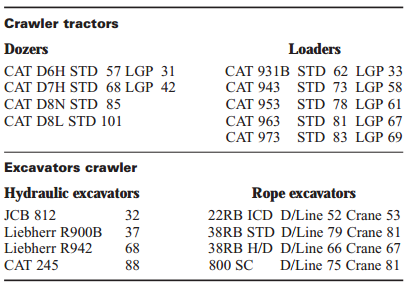Selection of the Construction Plant
The selection of plant is usually straightforward but the following points are relevant.
1- Cost
a- Hire rate
Take all factors into account if you are offered alternatives. What are the extras to the basic rate? For operated plant, these can include overtime, bonus and subsistence. Are fuel and lubricants included or excluded? Non-operated plant can sometimes be charged on a pro-rata basis for working hours above an agreed basic week (this arrangement is prevalent for diesel-driven generating sets). If you are offered a larger machine than you require, take into account any additional fuel costs (which can sometimes be significant) and check the haulage charge.
b- Fuel consumption
Figures for some machines may be available from your plant and transport depot. Delivery or collection charges These can be a significant part of the total cost, especially for short-term hire and should always be taken into account when evaluating alternatives.
c- Delivery or collection charges
These can be a significant part of the total cost, especially for short-term hire and should always be taken into account when evaluating alternatives.
2- Machine outputs
This subject would justify a separate book for each type of machine. It is not intended to cover this topic here. To assist planners, manufacturers’ literature can often be helpful. Of particular use is the Caterpillar Performance Handbook. Liebherr and Atlas Copco also produce useful manuals.
3- Ground conditions
As a general rule, wheeled machines are preferable if ground conditions allow them to work proficiently. Under extreme conditions a low ground pressure (LGP) crawler with extra wide tracks instead of standard width (STD) tracks, may be required. Mats may be useful under crawler cranes and excavators under similar conditions
Geotextile reinforcement under a blanket of good fill should also be considered. Table 1 gives some typical examples of ground bearing pressures. This data however must be taken in the proper context. Ground pressures under the tracks of a crane during lifting and slewing operations will vary considerably. Should there be any doubts about the machine loadings these must be fully investigated and adequate precautions taken.
Table 1 Tracked machine ground bearing pressures (kN/m2)
Particular care should be taken over the design, construction and maintenance of
piling platforms.
4- Size restraints
Check access onto the site, loading on roads, traffic routes and police escorts. Are there any obstructions, low bridges, overhead power cables or other structures? Will a structure to be built as part of the contract obstruct the machine’s removal? Is there room for the machine’s tail-swing?
5- Space requirement for mobilization
Crawler cranes and some large mobiles require a fairly large area for rigging (or for re-rigging if altering configuration). Craneage for the erection of tower cranes or batching plants often requires considerable space. For example, a 22RB with a 24 m boom requires a clear space of about 9 m x 32m and a 38RB with a 30m boom and 9m fly-jib requires about 10m x 50m for efficient mobilization.
6- Operation and maintenance
If in doubt about the operation of any plant delivered to site, ask for a manual and study it. If you are still in doubt, ask the supplier for a demonstration. The hirer will be expected to carry out the basic day-to-day checks on most of the plant used on site, whether in house or hired in. Ensure that site operatives are familiar with what is required. Major services, such as oil changes, are generally carried out by the owners, but check at the time of hire for hired-in plant.
Read More

